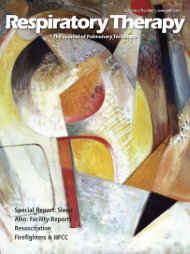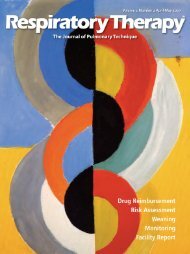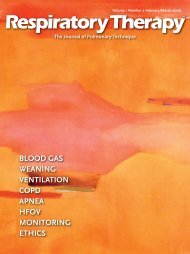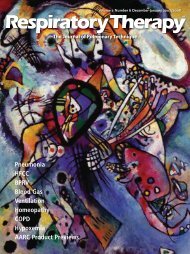RT 02-03 JJ07 main web - Respiratory Therapy Website
RT 02-03 JJ07 main web - Respiratory Therapy Website
RT 02-03 JJ07 main web - Respiratory Therapy Website
Create successful ePaper yourself
Turn your PDF publications into a flip-book with our unique Google optimized e-Paper software.
which lead to excessive daytime sleepiness and diminished<br />
neurocognitive function. In obstructive hypoventilation,<br />
increased airway resistance sufficient to cause partial airways<br />
obstruction and hypoventilation occurs, leading to peak end<br />
tidal CO 2>55 mm Hg or end tidal CO 2>45 mm HG for more than<br />
60% of the total sleep time. Snoring is common to all of these<br />
conditions. UARS and obstructive hypoventilation are not<br />
detectable using single channel screening, such as oximetry, but<br />
multichannel systems have the potential to identify obstructive<br />
hypoventilation and may also be useful in screening of UARS,<br />
the clinical significance of which has yet to be fully determined<br />
in children.<br />
Other conditions: In children with chronic lung disease and<br />
limited pulmonary reserve, such as infants with chronic lung<br />
disease of prematurity and children with cystic fibrosis, the<br />
normal effects of sleep on respiratory function can result in<br />
significant ventilatory and gas exchange abnormalities. 43<br />
Children may require higher inspired oxygen concentrations<br />
during sleep, whether or not supplemental oxygen is needed<br />
during wakefulness. These children can be identified by<br />
continuous assessment of oxygen saturation during sleep.<br />
Children with neuromuscular disease, especially those with<br />
progressive conditions such as Duchenne muscular dystrophy,<br />
will eventually develop respiratory disturbances during sleep. 44<br />
These are most pronounced during REM sleep due to<br />
diminished respiratory drive, atonia of the upper airway and<br />
intercostal muscles, and dependence of respiration on<br />
diaphragmatic function. Both obstructive apnea and alveolar<br />
hypoventilation can occur. Progressive scoliosis is often a<br />
contributing factor in these children. Mild hypercapnia and REM<br />
sleep desaturation are the first abnormalities to be observed and<br />
can be detected by combined recordings of gas exchange using<br />
oximetry and end tidal CO 2. Treatment is limited to supportive<br />
measures but these can prolong the duration and, most<br />
importantly, improve the quality of life for these patients.<br />
Sleep studies will also identify conditions in which there is an<br />
underlying abnormality in the central control of respiration.<br />
These conditions may be primary, such as congenital central<br />
hypoventilation syndrome (CCHS), or secondary to diseases of<br />
the spinal cord or brain stem. CCHS may range in severity from<br />
mild alveolar hypoventilation during sleep with adequate<br />
ventilation during wakefulness to complete apnea during sleep<br />
and severe hypoventilation even when awake. Infants usually<br />
present with cyanosis and respiratory failure, or occasionally<br />
apnea at birth. Rarely, infants present later with apparent life<br />
threatening events or cor pulmonale. Definitive diagnosis<br />
requires careful evaluation using PSG, including measurement<br />
of ventilation during wakefulness, REM, and non-REM sleep<br />
states. Treatment of CCHS is with long term support of<br />
respiration. As ventilation requirements will change over time in<br />
such patients it is necessary that PSG should be repeated at<br />
regular intervals. It is our practice to do so on a six monthly<br />
basis.<br />
Consequences of sleep disordered breathing in<br />
children<br />
Failure to recognise sleep disordered breathing in children can<br />
have significant consequences on growth, cardiac, and<br />
neurological function. Early surveys of children with severe<br />
OSAS reported failure to thrive in 27–56% of cases. 13,45 Increased<br />
recognition of OSAS and earlier intervention has made failure to<br />
thrive the exception in recent times. However, children with<br />
OSAS still tend to have a growth spurt following<br />
adenotonsillectomy. 46 This would appear to be due to decreased<br />
work of breathing postoperatively rather than to increased<br />
caloric intake. 47 Two studies have suggested that endocrine<br />
factors may also have a role. Increases in insulin-like growth<br />
factor (IGF-1) and its binding protein have been shown after<br />
adenotonsillectomy in children with OSAS. 48,49<br />
Recurrent nocturnal hypoxemia, hypercapnia, and respiratory<br />
acidosis can lead to pulmonary hypertension and on to cor<br />
pulmonale and congestive heart failure. This used to be a<br />
common presentation of OSAS in childhood but is now rarely<br />
reported. However, asymptomatic degrees of pulmonary<br />
hypertension may be more common than previously<br />
appreciated. Tal and others have shown reduced right<br />
ventricular ejection fractions in 37% of children with OSAS,<br />
although only 7% had clinical evidence of pulmonary<br />
hypertension. 50 All these children showed normalisation of heart<br />
function after surgery. Routine screening of children with<br />
suspected OSAS with ECG or echocardiogram is unlikely to be<br />
worthwhile.<br />
Systemic hypertension is a common complication of OSAS in<br />
adults but less frequently reported in children. Marcus and<br />
colleagues found that children with OSAS had a significantly<br />
higher systemic diastolic blood pressure (but no difference in<br />
systolic pressure) than children with primary snoring. 14 This<br />
observation raised concerns about the long term consequences<br />
to adult health of albeit mild increase of blood pressure during<br />
childhood associated with OSAS.<br />
Children with sleep disordered breathing have been shown to<br />
have a high incidence of neurocognitive and behavioural<br />
disturbances. 51–54 These include attention disorders, memory and<br />
learning disabilities, school failure, developmental delay,<br />
hyperactivity, aggressiveness, and withdrawn behaviour. 8<br />
Behavioral symptoms may be the primary clinical manifestation<br />
of sleep disordered breathing. Guilleminault and others showed<br />
that children aged 6 years and over who were referred to a sleep<br />
disorders clinic were frequently seen by the school counsellor<br />
before coming to the clinic, and concerns about attention deficit<br />
disorder and special educational needs had been raised. 52<br />
Rebellious behaviour was encountered more often than frank<br />
sleepiness. O’Brien and colleagues identified a high prevalence<br />
of sleep disordered breathing in children aged 5–7 years with<br />
mild attention deficit hyperactivity disorders (ADHD) compared<br />
with children with severe ADHD or none. 53<br />
Further evidence for a link between behaviour and neurological<br />
symptoms and sleep disordered breathing comes from studies<br />
that have shown improvement in these symptoms after<br />
treatment with adenotonsillectomy. 8,54 Gozal performed<br />
screening for sleep disordered breathing in first grade students<br />
who were performing in the lowest (10th) centile of their class.<br />
He found that a surprisingly high proportion (18%) were snorers<br />
with associated nocturnal gas exchange abnormalities. Children<br />
treated with adenotonsillectomy showed improvement in their<br />
grades the following year, whereas those left untreated did not.<br />
Guidelines for referral and investigation of suspected<br />
sleep disordered breathing in children<br />
The American Academy of Pediatrics has recently published<br />
clinical practice guidelines on diagnosis and management of<br />
74 <strong>Respiratory</strong> <strong>Therapy</strong> Vol. 2 No. 3 � June-July 2007











